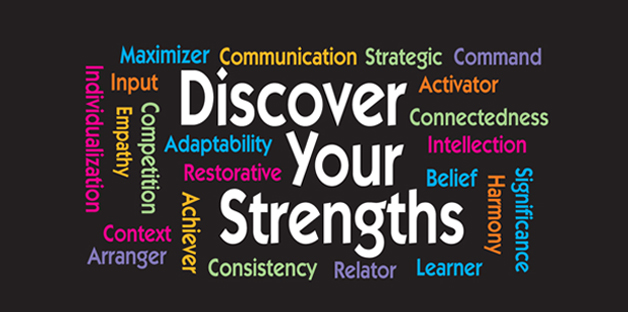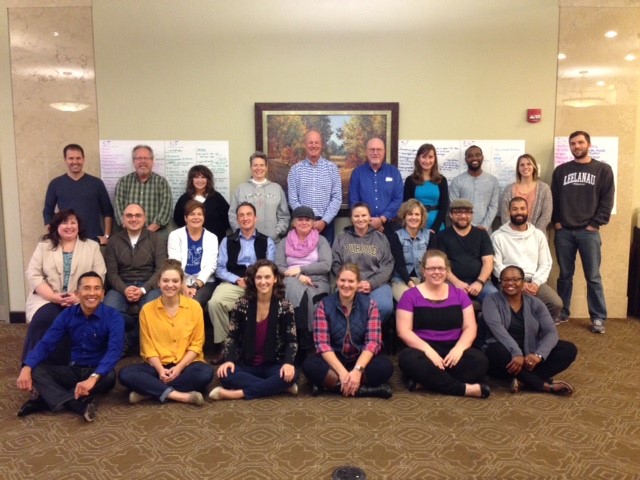 Article By: Jessica Knerr, Veronica Rahim, & Chrystal Randler
Article By: Jessica Knerr, Veronica Rahim, & Chrystal Randler
You’ve taken the StrengthsFinder, right? Did you know there is a 1 in 33 million chance to find someone who has the exact same talent themes in the exact same order as you? Holly Englert, Associate Director of Advising in Mechanical Engineering, shared this interesting fact during an interview about Strengths Finder. In addition, both Cher Yazvac, Associate Director for Career Development in the CCO, and Matt Davenport, Assistant Director of Residential Life for Legacy Lane & Engagement, were interviewed about their insights regarding this topic. All three of these Purdue professionals are Certified Strengths Coaches!
Among the many ways in which this university is staying on the cutting edge of innovation, Purdue recently became a Strengths Campus and is working cross-departmentally to develop this novel model! Considering the national popularity and credibility of this tool, three members of the Communications and Connections Committee (C3) investigated trends, interactions, and resources by interviewing a variety of campus professionals who would know best!
Being a newly established Strengths Campus has several implications across the University, and each of the Coaches were able to touch upon what this means. In Residence Life, Matt Davenport shared that they “are implementing the philosophy of the Strengths into the curriculum.” Cher Yazvac highlighted that there isn’t just “one way for it to be integrated” and “the focus of what Purdue will look like could be different than other campuses.” It seems that there is an opportunity for campus branding so our institution can have a unique feel in how we create our identity as a Strengths Campus. Holly Englert also noted that this allows us to “go deeper with students and help them discover what their Strengths are and help them apply that in a way that can help them be successful in the classroom and in their career development.”
While some may think the assessment points people in a certain career direction, the truth is that it is designed to help you figure out how you do something, rather than what you should do. Instead of adopting this tool as a diagnostic for career paths, users should be aware the assessment is going to focus on helping them understand which approach they typically take in a given situation. These approaches (or Strengths) are not good or bad – they are neutral until a person puts an intention behind it.
Yazvac cautions people to remember that the bite-sized Top 5 Strengths are not the complete picture. Many people can operate out of their top 10 on a day-to-day basis. This is good news for those of us that feel as though we have a Strength that was not listed in the Top 5 of the StrengthsFinder assessment. It does not mean it is not used; it just means that some other Strengths may come even more naturally than the ones you previously thought.
Along similar lines, try not to think of your bottom Strengths as weaknesses. The 34 Strengths all have potential for you to use, but your bottom strengths may not come as naturally as other strengths do, and that is okay. This holds true even if you truly enjoy a Strength found at the bottom of your list. Davenport illustrates this occurrence by using singing as a supposed Strength: “Some people love to sing and even though they aren’t good at it, they do it anyway. Some people don’t particularly love singing but they are good at it. This is not too dissimilar to Strengths. Some things you may be good at but don’t love. Some things you may be bad at but love anyway. It’s tapping into an awareness of these personal tools and learning how to best harness them.”
The Strengths Coaches have utilized Strengths in a variety of ways. Conversations around Strengths are happening with students in groups, through classes and workshops, and in one-on-one settings, like career counseling. Englert has led Strengths workshops in ME 290. The CCO staff have gone into classrooms and residence halls, incorporating Strengths into career exploration workshops. Lessons on Strengths are also utilized in EDPS 105 and in workshops for fraternities, sororities, cooperative houses, and other student groups. In addition to using Strengths with students, staff in at the CCO, housing and dining, and other offices use Strengths for teambuilding and professional development. The opportunities abound to incorporate Strengths into work in student affairs.
A wide variety of resources exist for both advisors and students, which the three Coaches shared liberally! They include the following, many of which both advisors and students can use:
- Strengths 2.0 Book (Downloadable e-Version access when Logged In on Gallup website)
- Online Gallup Resources (Access when Logged In)
- Purdue myStrengths Web Portal (4 Career Assessments under the “Resources” Folder and within the “View Additional Resources” Tab among many additional links and resources)
- Strengths Facebook Groups
- Strengths YouTube Channel including Themed Thursday Podcasts
- Access Purdue’s Certified Gallup Strengths Coaches for Individual or Group Interactions
We asked the interviewees what their Top 5 Strengths are and which ones resonated with them the most. Davenport said his are: Activator, Maximizer, Communication, Competition, and Positivity. Interestingly, he felt as though his 6th Strength, Woo, was the one that resonated the most with him. While Woo might be conceived as a manipulative or negative trait because it consists of “winning people over” (Gallup, 2017), it really comes back to the intention of the user. Provided the person employing Woo is operating from the “Balcony” and not the “Basement”, the Strength is a great asset to the person and employer.
Englert stated her Strengths are: Empathy, Developer, Positivity, Communication, and Input and that Empathy resonates most with her. She believes it drives who she is as an individual and is highly relatable to her other Strengths. The genuine connection she feels through Empathy gives her an edge within advising because she can understand when to push a student and when to back off.
For Yazvac, her Top 5 strengths are: Communication, Connectedness, Empathy, Strategic, and Maximizer. She feels as though all of these resonate with her. However, she has intentionally focused more of her attention to the Strategic strength. She believes by developing this strength, it will help her with her other strength, Maximizer.
We should remember that implementing StrengthsFinder is a learning process for the students, faculty, and staff at Purdue so there are going to be some questions along the way. Thankfully, Purdue has provided a solid foundation to our advising and student services community to help navigate this new tool. For those finding the process to be a bit overwhelming or a bit lost as to how to get started with Strengths, we recommend that you start with yourself. By learning your own strengths and how they affect your work, you can better help your students tap into their Strengths within their academics and future careers.
Keep in mind that Gallup and Purdue have additional tools for you to use that we previously mentioned in this article. Reach out to the Strengths coaches here on campus if you want to continue your education or have them assist in your curriculum. You can find them by visiting here: .
We would love to hear how you are implementing Strengths in your work with students! Please feel free to reach out to the contacts listed below to let us know. We may contact you on future articles regarding Strengths methodology!
Jessica Knerr (knerrj@purdue.edu)
Veronica Rahim (vrahim@purdue.edu)
Chrystal Randler (crandler@purdue.edu)
